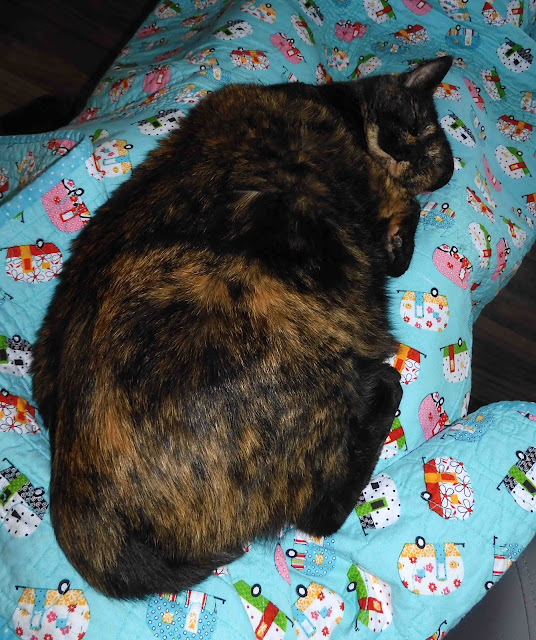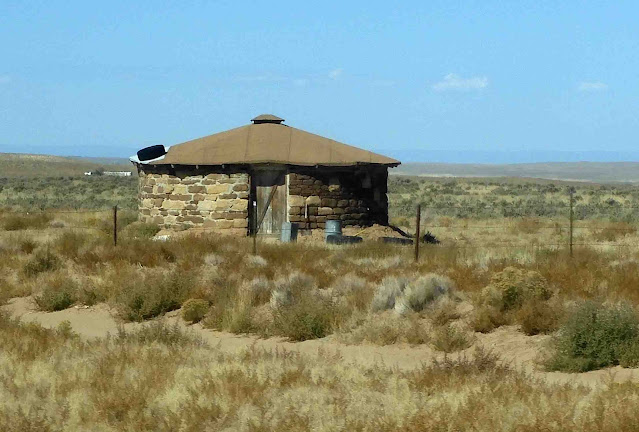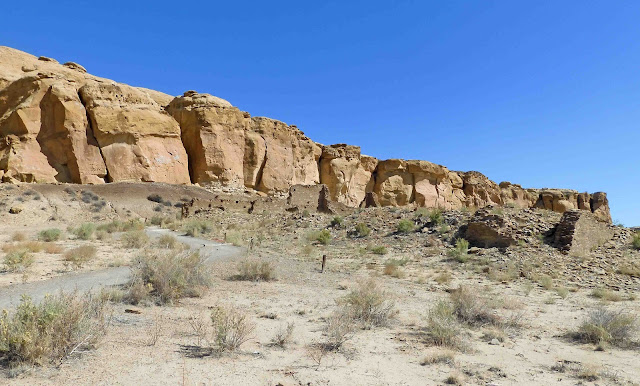There were two venues we wanted to see while here in Bloomfield. The longest (and most teeth-rattling) journey was to Chaco Culture National Historical Park. We chose to do that one first. The morning started with the usual lap occupation. One thing about traveling: the kitties get plenty of lap time.
It's hard to get up and leave her when she looks this comfy.
But, cruel kitty parents that we are, we did leave. We headed due south on US Hwy 550 for some miles before turning off on a county road leading to the park. The landscape is pretty barren out here.
To the left, we could see Angel Peak off in the distance. It's elevation is nearly 7,000 feet. I took some pictures of it when we drove into Bloomfield, but this one is from the
Angel Peak Scenic Area website. It is a part of the Bureau of Land Management, our public lands. You can read more about it at that link I've given you.
We saw some abandoned structures (and, indeed, some lived-in ones) along the way. It seems a grim existence here. The areas surrounding us are a part of the
Navajo Nation.
We saw several of these round structures. I believe it is what's known as a "
Hogan," a traditional Navajo dwelling and ceremonial structure.
After a short distance, we hit a gravel road. We traveled some 15 miles on this road, and believe me, it was enough to rattle the teeth right out of your jaw. Mike was very brave taking his truck baby across this long suspension-killing stretch. Oh yes, and watch where you're going. This is open range.
We saw some wild horses too.
At times, the dirt turned red, and we wondered why. It appeared it had been washed across the road, rather than trucked in for some reason.
Reaching pavement shortly before the park was a soul-soothing salve. The loop road inside the park is completely paved.
So, I'm going to show you a series of informational signs. Read them, or don't. Your choice. It explains a little about what is to follow. Chaco culture is not just one tribe's history, but a community of tribes working cooperatively.
These are some of the tribes represented.
You'll notice the large number of round rooms as you scan these pictures. The sign below offers some information about that.
Pueblo Bonito was the last of the structures we visited. It was very impressive. Pictures to follow.
Current Stonehenge theory has that the structure was built with seasonal events in mind. Theoretically, Chaco was built in the same way.
It was a gathering place with many purposes.
After taking in the information at the visitor's center, we ventured out along the loop road. The first stop was Hungo Pavi.
It didn't look like much from the parking lot.
Walking out, we were surprised to find many very large structures. In the image below, Mike is showing how some of the walls were as much as three feet thick.
The stone-masonry was exquisite. Some of these structures were three floors high with wood-beamed roofs and supporting structures. Keep in mind that some of this is more than 1,000 years old.
The walls were tall, and the shade was nice. The temperature was only in the low 80's, but it was hot in the bright sunshine.
Up high, we could see where log beams supported roofs.
Smaller logs supported window and door openings.
The round rooms at Chaco are what makes this place stand out from other ruins in the southwest. Here's the first one we encountered in our wanderings.
We were amazed at the size of this place. Look at the length of the wall in the image below.
I don't have a lot to say about the images that follow, and so I'll just let you look.
There were a couple of crows flying around "cawing" furiously while we were exploring here. They seemed to have a nest in the cliffs behind. We could hear another pair answering off in the distance.
We also saw a lot of very industrious red ants.
We noticed some of the structures were shored up with modern lumber and fittings.
When we traveled in Belize some years ago, we visited Mayan ruins at
Xunantunich. Our guide was a young man of Mayan ancestry. He told us a few things that were interesting. For one, he explained that once a ruins is uncovered (the ones in Belize are mostly grown over with jungle), it either has to be restored, or it has to be covered over again. If not, the whole thing will eventually collapse and be unsalvageable.
In the image below, you can see that the wall is leaning to the right, and it has been shored up by the parks department.
Our Mayan guide also told us that, contrary to popular belief, the Mayan people didn't "disappear." He himself was evidence of that. But their spiritual beliefs included things like human sacrifice to please the gods during hard times. During extended periods of famine or drought, a king might demand the sacrifice of certain children or other loved ones. Think about that, and then think about what might happen if these demands were made too frequently. The people might have said, "I've had enough of this," and then left the community, rather than give up yet another loved one. It's a theory, and it makes sense. As for this place, who knows? Perhaps they exhausted the resources of the area, or water dried up. It's anyone's guess why these structures were eventually abandoned.
As for yesterday's visit, this place led to the next one. We walked along the Petroglyph Trail, watching for petroglyphs as we went.
At the end of the trail, we came to Pueblo Bonito, the largest of the ruins in the park.
I was getting kind of pictured out by this time, and so I took fewer pictures, but I think you can get the idea. It was similar to the one we'd already seen, except even larger.
I took a couple of panos to try to capture its size.
Around the back side was a short trail to Wetherill Cemetery. Mike headed back to the truck at this point. We were hot, sweaty, and dusty. I wanted to see the cemetery, and so I walked on.
I was expecting a cemetery related to the ruins, but it turned out to be a settler from the late 19th century. There were just two headstones here.
Poor Mr. Wetherill didn't have a very long life. You can
read more about him right here. He has his own place in history. He is credited with the discovery of Cliff Palace in Mesa Verde. Wikipedia tells us he remained in Chaco Canyon, homesteading and operating a trading post at Pueblo Bonito until his controversial murder by gunshot in 1910. Depending on the source, Wetherill's death was murder in cold blood by a Navajo Indian debtor or the manipulation of the local Indian Agent against the Wetherills due to political factors over the use of the Canyon. The agent, Statcher, wanted to dam the canyon for water, fence both ends for grazing and build an Indian School (a shameful forced "Americanizing" of the natives) among the ruins. Local Navajo Chiishchilí Biyeʼ‚ was charged with his murder, served several years in prison, but was released in 1914 due to poor health.
His wife, Marietta, lived decades beyond him. She went on to write a book, entitled
Life with the Navajos in Chaco Canyon. First published in 1992 and now available only from the University of New Mexico Press, this is a firsthand account of their lives. She got to know her Navajo neighbors as intimately as an Anglo could. While her husband was excavating at Pueblo Bonito, Marietta managed the trading post. She befriended a singer who adopted her into his clan and gave her a close-up view of Navajo medicine and religion.
After taking a look at the cemetery, I headed back to the truck, and we made the long drive back over that same bumpy gravel road. I can tell you that seeing the approaching pavement was a sight for sore eyes.
We managed to poke our teeth back into their sockets, and we headed back to the camper.
This morning, we'll check out another site, The Bisti/De-Na-Zin Wilderness. It is described on the website as a rolling landscape of badlands offering some of the most unusual scenery found in the Four Corners region. I'm expecting something along the lines of Goblin Valley in Utah, but I'm not sure. It was created by the same forces at work there.
We have one more day here in Bloomfield, and then we'll head off to Bernalillo, just north of Albuquerque for a couple of nights.
























































14 comments:
Some people call structures like the Egyptian Pyramids as 'Ancient Ruins', but we call them 'Perfect Bridges' where we can reach and touch the wonderful masters of the past! ~ Mehmet Murat Ildan
Another fascinating read Barbara - I think seeing those structures was worth the bone-rattling drive to get there. Amazing how they were able to build those with the primitive tools they had and even more amazing that they had the vision to do so.
Amazing photos of an ancient people's way of life. Thanks for sharing with all of us.
I bet Sadie was glad she didn't have to travel down that road. She probably thought having to move from your lap was bad enough.
Interesting/fascinating place. I would love to visit that area sometime.
I have long been fascinated with Native American history, culture, religion ~ life before white contact. Your post today is fascinating. Look at how perfectly those stones were placed and aligned with the sun, moon, and stars. Thanks for your wonderfully interesting travelogue!
Fascinating. I'm sure the rugged gravel road deters sightseers, which is a good thing. One can only imagine how much vandalism and plundering might occur if it was easier to get to.
Pat
I have now added this National Park to my bucket list. So much history. I've been to Mesa Verde, but Chaco seems so much larger and more history. Thanks for sharing and inspiring.
Amazing that we have this in our "young" county, I am so happy that I am traveling with you on your back bumper and getting to see all of this. Thank you
How superb was this trip! What fascinating history. Love it
Thank you
What an amazing place. Beautiful and desolate. It is fun to imagine it full of life and laughter.
Chaco Canyon is an amazing place. We visited in the mid 1990's, as young, broke, just out of college kids, so we camped there. I'd heard that due to visitor traffic they'd covered up some of the buildings to preserve them. Looks like there is still a lot to see.
Fascinating, I think it might have been worth the teeth jarring road;) I assume you couldn't ride your ATV's there?
I'm so glad you persevered over the bone-jarring road to reach this destination, and thank you for sharing the photos and descriptions. A fascinating post!
Fascinating! Thank you four bringing history to life! Wow, what a marvel of engineering. Mike must have been simply enthralled the whole time. I can just imagine the hustle and bustle of life back then, trading and celebrating.
Post a Comment